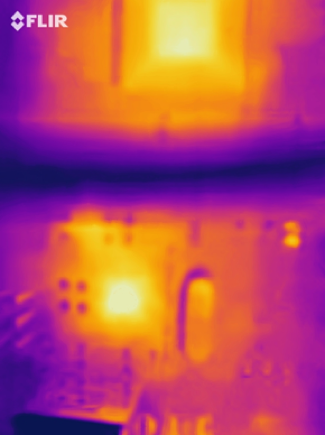Stanford, U of A Engineers Look to Future of Electronics at Research Workshop

Infrared thermal imaging of an electronic system illustrating the high temperatures on devices. Researchers are working to increase how much heat electronic devices can withstand while still functioning.
Researchers and industry partners gathered in Fayetteville last month to chart a course for the next generation of batteries, microprocessors and power electronics — including changes that could revolutionize how automobiles, aircraft and spacecraft are designed in a growing electrified fleet.
The workshop was hosted by the Center for Power Optimization of Electro-Thermal Systems, also known as POETS.
Participants included researchers from the University of Arkansas, Stanford University, University of Illinois-Urbana Champaign and Howard University.
The workshop was led by Debbie Senesky, assistant professor of aeronautics and astronautics at Stanford University, and David Huitink, assistant professor of mechanical engineering at the University of Arkansas.
The workshop introduced the questions, "What could be accomplished if the power electronics, microprocessors, and batteries of the future ran hotter (perhaps as high as 500 degrees Celsius, or more)? How would this new operating point revolutionize the design of automobiles, aircraft, and spacecraft?"
The Center for Power Optimization of Electro-Thermal Systems is working to design and develop vehicle electrical systems that are more powerful, efficient and heat-resistant.
The long-term goal is to increase the power density of current mobile electrified systems by 10-100 times over current state-of-the-art systems. Results from the study could save highway vehicles between 100-300 million liters of fuel per year.
A great challenge in today's semiconductor industry, Huitink said, is the thermal limit of electronic devices — the maximum temperature at which devices can operate.
Increasing that limit would give engineers more options when designing electronics, which could make the final products smaller, cheaper and more efficient at delivering power.
The limit is approximately 250 degrees Celsius (482 Fahrenheit) for commonly used silicon for semiconductors, and often less than 150 Celsius (302 Fahrenheit) for their associated packaging.
That limit prevents the engineering of safe electronic systems with power densities exceeding about 1 kilowatt per centimeter-squared, Huitink said.
To overcome these significant environmental challenges, engineers integrate active cooling systems or complex packaging into the design of electronic modules to make them more durable, but those fixes can significantly increase cost and payload requirements. The workshop was designed to help researchers and businesses address those issues.
"Building on the current successes in POETS and standing upon the shoulders of the 'giants' in power electronics research was the fundamental premise in this workshop," Huitink said. "We have a spectacular team in POETS, through whom we expect to revolutionize the capabilities in mobile power electronic systems. Bringing the key minds in device, packaging, sensing and reliability of these systems together with the major industrial partnerships, ranging from electric vehicles to aircraft and heavy machinery helps us to pinpoint technical challenges, which we can then work together to solve."
About Power Optimization for Electro-Thermal Systems Center: The center is a National Science Foundation Engineering Research Center. At this center, engineering faculty from the University of Arkansas, University of Illinois at Urbana-Champaign, Howard University and Stanford University collaborate with members of industry to identify and carry out research projects to improve the power density of next generation electro-thermal systems that are the most relevant to industry needs.
For more information on high ambient temperature systems, contact David Huitink, dhuitin@uark.edu. For more information on the Power Optimization for Electro-Thermal Systems Centerr, contact Alan Mantooth, deputy director, at mantooth@uark.edu.
Topics
Contacts
Karin Alvarado, marketing and communication specialist
College of Engineering
479-575-4958,
karina@uark.edu
Nick DeMoss, director of communications
College of Engineering
479-575-5697,
ndemoss@uark.edu
Headlines
PetSmart CEO J.K. Symancyk to Speak at Walton College Commencement
J.K. Symancyk is an alumnus of the Sam M. Walton College of Business and serves on the Dean’s Executive Advisory Board.
Faulkner Center, Arkansas PBS Partner to Screen Documentary 'Gospel'
The Faulkner Performing Arts Center will host a screening of Gospel, a documentary exploring the origin of Black spirituality through sermon and song, in partnership with Arkansas PBS at 7:30 p.m. Thursday, May 2.
UAPD Officers Mills and Edwards Honored With New Roles
Veterans of the U of A Police Department, Matt Mills has been promoted to assistant chief, and Crandall Edwards has been promoted to administrative captain.
Community Design Center's Greenway Urbanism Project Wins LIV Hospitality Design Award
"Greenway Urbanism" is one of six urban strategies proposed under the Framework Plan for Cherokee Village, a project that received funding through an Our Town grant from the National Endowment for the Arts.
Spring Bike Drive Refurbishes Old Bikes for New Students
All donated bikes will be given to Pedal It Forward, a local nonprofit that will refurbish your bike and return it to the U of A campus to be gifted to a student in need. Hundreds of students have already benefited.




